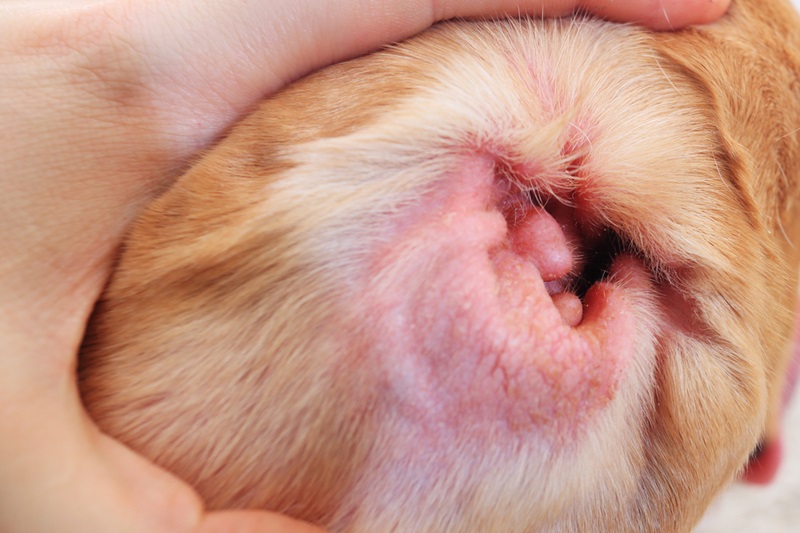Have you ever noticed your pet scratching their ears more often? Perhaps your dog or cat is shaking its head more frequently than usual. If so, you might be concerned if there’s an underlying issue. Dogs typically need regular ear cleaning more than cats. Cats are usually good at grooming themselves, so they don’t need as much help in that area. However, if you see signs of ear problems in your pet, it’s best to consult a veterinarian. If it turns out to be just a matter of cleaning rather than an infection, you may need to use pet ear wash.
When To Clean Your Dog’s Ears?

Knowing when to clean your dog’s ears is important to maintain their ear health. While some dogs may not require regular cleaning, others may need it every week to prevent infections. It’s important to avoid over-cleaning as it can irritate the ear canal. A healthy ear is typically pink, odourless, and free of debris. If you notice any odour or discharge, it’s a sign that cleaning is necessary. Dogs with allergies, long ears, or those who swim frequently may require more frequent cleanings.
Consulting with your veterinarian will help determine the appropriate cleaning schedule for your dog’s ears. Regularly inspecting your dog’s ears for any signs of odour or discharge is essential to ensure their ear health and make the cleaning process easier for them. If you notice redness, inflammation, or pain in your dog’s ears, it’s best to contact your veterinarian before cleaning, as they may have an infection or a ruptured eardrum.
Factors to Consider When Purchasing Pet Ear Cleaner
There are many options available when it comes to pet ear cleaners, and you can even find various recipes for homemade solutions online. Always choose a veterinary-approved ear cleaning product to ensure its effectiveness and avoid any potential irritation.
Purpose
Determine whether you need the product for regular ear cleaning or if your dog has an ear infection that requires treatment. For routine cleaning, choose a gentle pet ear wash that can remove dirt, wax, and pollen. If your dog has an ear infection, consult your veterinarian for a suitable cleaner that targets the specific pathogen causing the issue.
Ingredients
Always read the label and check the active ingredients. Avoid products that contain alcohol or hydrogen peroxide as they can harm the sensitive ear tissue. Look for ingredients like salicylic acid and lactic acid, which have antimicrobial properties and can prevent the growth of yeast and bacteria. Ketoconazole is an antifungal agent used to treat yeast infections, while hydrocortisone is a mild steroid that helps reduce irritation and itchiness. Aloe vera is also beneficial as it naturally cleans the ear and reduces inflammation and odour.
Liquid products and chemically treated wipes – wipes are more convenient and less messy to use, but they are not suitable for deep cleaning.
Don’t forget about scent; a mild scent can help mask any unpleasant odour, but products with a strong smell may bother your pet.
The Cleaning Process
To begin, locate a cozy spot where you and your furry friend can feel comfortable to clean their ears. Keep in mind, that things might get a bit messy. The bathroom, garage, or patio are all suitable options.
- Step 1 – Gently lift your pet’s ear flap with one hand and tilt it slightly back towards the top of their head. This will help straighten the ear canal.
- Step 2 – Using your other hand, pour the ear cleansing or flushing solution into the ear canal. Be careful not to let the nozzle touch the ear canal to prevent contamination.
- Step 3 – Let go of the ear flap and softly massage the base of the ear between your thumb and fingers for one to two minutes. This will assist in removing any wax or debris lodged deep inside the ear canal.
- Step 4 – Step back and let your pet to shake their head. Have a towel handy, as things might get a little messy.
- Step 5 – Use dry cotton balls or soft gauze to wipe away any excess cleaning solution and debris from the outer ear. No need to completely dry the ear.
How Often Should You Check Your Pet’s Ears

Make sure to check your pet’s ears at least once a week. Look out for any signs of trouble during your inspection:
- Discharge – if you see brown or black discharge that looks like coffee grounds, chances are your pet has ear mites. These annoying bugs feed on wax and oil in your pet’s ears and can cause discomfort. If left untreated, they could harm the eardrum.
- Scratching – some ear scratching is normal, but if your pet can’t stop scratching, it could be a problem. Excessive scratching and pawing at the ears can lead to bleeding and infections.
- Redness – red, swollen, or warm ears could indicate an ear infection in your cat or dog.
- Odour – a bad smell coming from your pet’s ears might signal an infection.
- Pain – does your pet yelp or flinch when you touch their ears? This could mean an infection or injury.
- Foreign objects – watch out for anything strange in or on your pet’s ears, like grass, pebbles, burrs, or ticks.
- Head shaking – if your pet keeps shaking their head, they might be trying to relieve ear discomfort.

Leave a comment